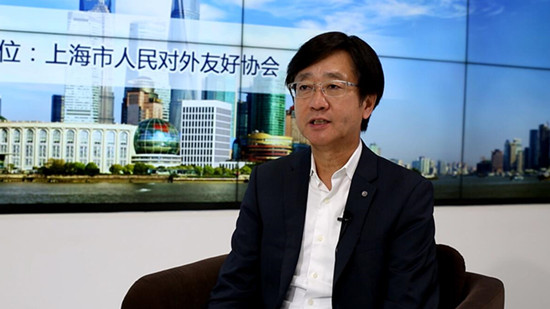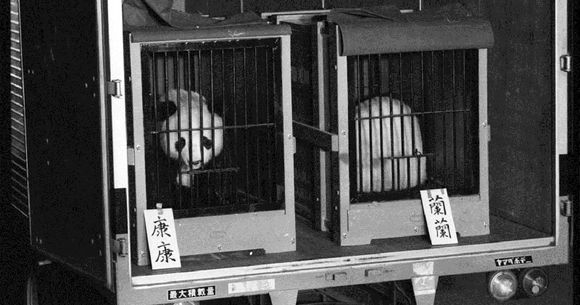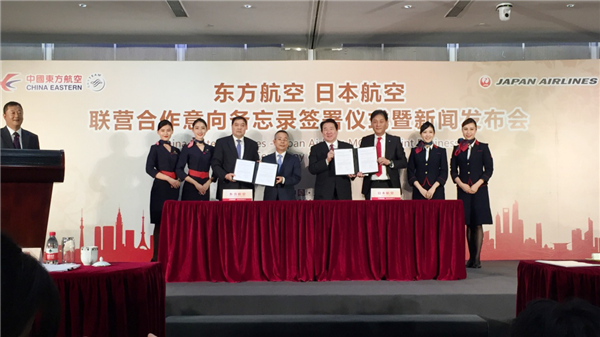“I have been to many cities in the world and am therefore quite familiar with airports all over the world. But it is the first time that I have transferred from an airport to a high-speed train. The aviation industry of China is developing fast, with a long-term plan and a focus on branding, just like the way China is developing now.”
Akira Yonezawa, current Executive Officer of Japan Airlines, has been working for the company for 34 years since he joined the company in 1984. He once served as Manager of the Shanghai Office at Japan Airlines between 2008 and 2010. This is the second time Akira has taken on a challenge in China.
Witnessed the dramatic changes during two periods of employment
Talking about the changes of Shanghai, Akira Yonezawa was also amazed by the construction speed of metro railways in Shanghai. “I was in Shanghai in 2010 when Shanghai held the World Expo and Line 10 officially opened for service and now Line 17 has been put into operation. Shanghai today boasts the world’s longest subway system in terms of length, which is longer than the metro systems in New York and Tokyo."
Akira Yonezawa first vivisted China more than 30 years ago. In his opinion, Chinese people are wealthier now and can feel free to travel within China or abroad. "After the reform and opening up, Chinese tourists have been seen all over the globe, enjoying the scenery and cuisines of foreign countries. Moreover, more and more foreigners have come to China. This movement of people has gone a long way towards cultural exchange."

Photo: Akira Yonezawa during the interview
Cultural exchange and friendship
On September 25, 1972, the charted flight offered by Japan Airlines to Prime Minister Kakuei Tanaka for his visit to China landed in China for the first time. In October of the same year, to celebrate the normalization of diplomatic relations between Japan and China, a pair of pandas, which symbolized the Sino-Japan friendship, were sent to Japan as gift. The two pandas Kangkang and Lanlan lived in Ueno zoo in Tokyo after their arrival and soon became a hit in Japan. It was Japan Airlines that transported the two pandas.

Photo: Kangkang and Lankan, symbol of Sino-Japan friendship
On September 29, 1974, two years after the normalization of Sino-Japan relations, Japan Airlines opened a flight to Mainland China and has since served as the aerial bridge for transportation of people and cargo between China and Japan.
During the Great Tangshang Earthquake in 1976 and Wenchuan Earthquake in 2008, Japan Airlines participated in the rescue activities by transporting emergency goods to the disaster areas.
In 2009, due to the loosened travel visa policy, more and more Chinese people began to travel to Japan. There were also changes in terms of Chinese tourists themselves. More group tours have been replaced by personal tours, while smaller cities in Japan have been gradually favored over mega cities, and experiences favored over mere shopping.
Akira Yonezawa said that the function of an airport is not only to transport passengers but also to convey culture and spirit and Shanghai as a global city should take the responsibility to convey Chinese culture.
According to statistics, 112 million passengers passed through Shanghai airports in 2017, ranking 4th among the global cities. In 2017, 7.35 million Chinese tourists traveled to Japan, an increase from only 1.41 million in 2010. The number of tourists to Japan skyrocketed by more than 5 times. Meanwhile, Chinese tourists have brought Chinese culture to Japan during their visits.
A better tomorrow for civil aviation industry
In April, 2018, President Xi announced at the Boao Asian Forum that China will take further steps to open up. On June 28, the Ministry of Commerce released the Special Management Measures (Negative List) for the Access of Foreign Investment (2018) and significantly widened market access. The new Measures cancelled the restriction on foreign stockholding limits in such aviation vehicle segments as trunk airplanes, regional aircrafts, general aircrafts, helicopters, drones and lighter-than-air crafts. This new policy will energize China’s aviation market and bring the development of China’s aviation industrial chain to a new level.
In terms of cooperation in the aviation industry, Akira Yonezawa told us that, as early as in 1979, China had sent flight attendants to Japan for training at Japan Airlines. In 1981, Japan Airlines was entrusted by the Civil Aviation Administration of China (CAAC) to perform maintenance for Chinese civil airplanes. In 1997, in return, airplanes of Japan Airlines were serviced in Xiamen. It could be said that Japan Airlines has witnessed the development of China’s aviation technologies.

Photo: Japan Airlines and China Eastern Airlines held a signing ceremony for their joint venture cooperation MoU.
Recently, Japan Airlines and China Eastern Airlines signed a memorandum of understanding to pursue a joint business agreement to capitalize on a boom in Chinese tourism. The cooperation will involve both the main flights between China and Japan and the domestic flights in both markets.

Photo: Wishes for China's 40 years of reform and opening up——Flying Japan Airlines amid Sino-Japan friendship
At the end of the interview, Akira Yonezawa expressed his wish that Shanghai will leverage China's advantages in Internet and big data to further improve the security and convenience of its airports to provide even better services to passengers from all over the world, while Japan Airlines will make further contributions to the cultural and economic exchange between the two China and Japan.
